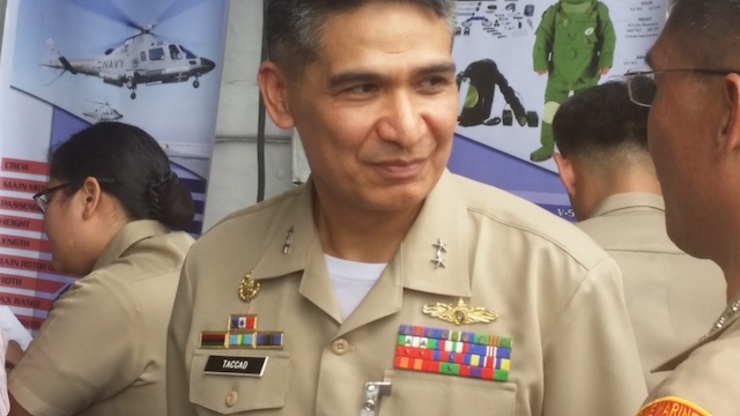The first step is the creation in 2013 of a submarine office in the Philippine Fleet 'to start developing the necessary skills and infrastructure,' says Navy Vice Commander Caesar Taccad

MODERNIZATION BRIEFING: Navy Vice Commander Rear Admiral Caesar Taccad boasts of the Navy's new assets
The Philippine Navy has formed a submarine office to start the decade-long process of developing people and facilities to prepare them for the possible purchase of submarines, Navy vice commander Rear Admiral Caesar Taccad said in a modernization briefing on Wednesday, December 17.
"Submarines take a lot of gestation period. The rule of thumb in the development of support facilities, the people and technology of operating such a force is 10 years. Now when should we start? We can start now so we can [acquire] 10 years from now," Taccad said.
The first step is the creation in 2013 of a submarine office in the Philippine Fleet "to start developing the necessary skills and infrastructure." It is part of the discussions on what to acquire next after the ongoing P90-billion fresh modernization program is completed.
The second step, Taccad explained, is to have at least 3 submarines. "But if you cannot afford three, get two just like we're getting two frigates and two strategic sealift vessels so they can replace each other during maintenance.
If you only procure one and continuously use it, it will only last for 5 years," Taccad said.
One of the weakest in Southeast Asia, the Philippines is modernizing its navy to achieve minimum credible defense in the wake of escalating tension in the West Philippine Sea (South China Sea).
Money is an issue. While China and other neighbors are acquiring submarines, the Philippines is pouring its money into the acquisition of patrol frigates for maritime domain awareness or the ability to monitor what is happening in its waters.
"Maganda sana kung mayroong (It would be great if we could have) submarines, frigates and the multirole fighters. But we need to prioritize so we prioritized the multirole fighters and the frigate," said Taccad.
The Philippine government allotted P90 billion to the military's modernization. The P18.9-billion frigates for the Navy and P18-billion fighter jets for the Air Force are the two big-ticket items that it funded.
"The system of defending the country involves several types of capabilities. The first capability will be what we can afford and yet cover a large space and this will be the patrol vessels. These are low-tech equipment, and low-cost. You can have more and cover a large space," said Taccad
The next stage of modernization is where the submarines can play a role. If the patrol vessels are harassed, for example, the more sophisticated assets like submarines can serve as deterrence to "scare off" intruders.
"If there's a confrontation, we need a capability to protect our patrol vessels so they will not be harassed. These are the high-tech weapon system, which is more sophisticated and therefore costly. We may use frigates with missile capability just to scare off...or it could be the submarines as deterent," said Taccad.

No comments:
Post a Comment
Note: Only a member of this blog may post a comment.